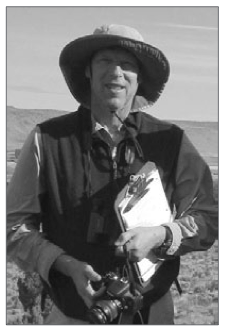Paul Slichter
Last Updated on March 23, 2024 by Tom Pratum

A computer search for photos of Pacific Northwest plants, using a scientific or common name, often finds Paul Slichter’s treasure trove of plant photos and information called Flora and Fauna Northwest. Over the years, Paul developed this website that offers plant lists for a variety of popular locations in Oregon and Washington, plant images, user-friendly keys, and many other excellent and useful features such as an especially nice section on birds. Paul started the website about 1994 as an aid to teaching Gresham High School biology students the 40 wildflowers they were required to know. Because they also needed to make a wildflower collection, he began adding Gorge wildflowers, then added leaves and trees and shrubs to assist their efforts. The rest of the website was an expansion from the botany section.
Mountains, which required a great deal of travel for scouting and becoming familiar with plant phenology. In addition to the traditional Saturday outings, he offered two field trips on Friday and one on Sunday. These extra trips, two of which he led, were very well attended and gave members the opportunity to learn from three field trips at the Annual Meeting.
In August 2004 he began assisting David Biek and Susan McDougall, co-authors of The Flora of Mount Adams, Washington. He visited between 30 and 50 sites around Mount Adams each season through the fall of 2007, when the manuscript went to print. He explored not just the high country, but all the lower slopes of Mt. Adams (excluding the Yakama Reservation) as well, listing the plant species in those areas and contributing greatly to the botanical knowledge of the region.
He tagged many of his photos with both scientific and common names, greatly facilitating computer searches.
Paul was reared near Spokane, and he has a special fondness for the drier climate of eastern Oregon and Washington. He completed an undergraduate degree in biology, chemistry, and education at Central Washington University in Ellensburg, followed by graduate work at Portland State. His first plant collections were from Klickitat County in 1978 for his first plant taxonomy class. During the summer of 1974 he worked on a road crew for the Gifford Pinchot National Forest. This is when he began photographing wildflowers during hikes on Mt. Adams and exploring the Dark Divide Roadless Area between Mt. Adams and Mt. St. Helens.
He joined the Native Plant Society of Oregon in 1986 after he began attending spring wildflower shows held by the Portland Chapter at the Western Forestry Center to become more familiar with the local flora, information that he could use teaching his biology classes. Russ Jolley presented slides from the Gorge at one of those flower shows, which inspired Paul to take more of his own wildflower photos and develop a collection of wildflower slides for his students. He found Russ, Jerry Igo, Barbara Robinson, Lois Kemp and Jan & Dave Dobak to be great field trip leaders and inspiring teachers, and he used Jolley’s book, Wildflowers of theColumbiaGorge, to become proficient at searching for new species. Before long Paul was leading field trips himself, and then served as field trip organizer for the Portland Chapter for two years. In 2003, when the Portland Chapter hosted the annual meeting in John Day, Paul organized the field trips, which involved driving 250 miles to explore trails, learn the flora, and recruit hike leaders in the John Day area.
Paul retired from teaching in 2008. In 2011, he volunteered to organize field trips when the Portland Chapter hosted the Annual Meeting in Logan Valley south of the Strawberry
In 2009, he began doing plant surveys for the University of Washington’s Rare Care project, performing two to three listed monitoring projects in the Gorge each year. He found enough new rare plant locations to send in about a dozen or so new sighting reports each season. Among the rare plants he located was a population of more than 1,500 Western ladies’ tresses orchid (Spiranthesporrifolia) in the Catherine Creek area, which is more than had previously been found in Washington. His surveys helped convince the Forest Service that the Catherine Creek area merited special management for disturbance activities (e.g., trail building, horseback recreation), and may bolster future preservation efforts. In summer 2011 on Friends of the Gorge Land Trust land, he discovered Orobanchecalifornicassp. grayana, which was thought to have been extirpated from Washington State because it had not been seen since 1882. He plans to continue with Rare Care this year, as well as monitor at least one species for the NPSO Citizens Rare Plant Monitoring Project.
In short, since retiring Paul has taken on a second career as a field botanist. This self-described “Nature Bum” is finding great pleasure in exploring new places, photographing plants, surveying, keying, and making species lists, and going to workshops. He has been leading NPSO hikes for at least a dozen years, which he feels is a way to give back to NPSO for all the help previous leaders had given him. He has also given at least a dozen presentations to NPSO chapters, including the Cheahmill, mid-Columbia, Portland, and Willamette Valley chapters. In the fall of 2011, he joined the Advisory Board for the Oregon Flora Project. His constant joy in discovery and his pleasure in sharing his knowledge with others serve as his most important contributions to NPSO and the botanical community.
–BarbaraRobinson,Mid-ColumbiaChapter.
